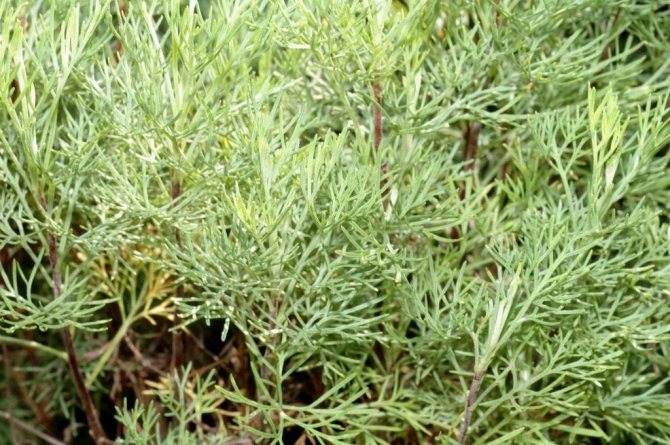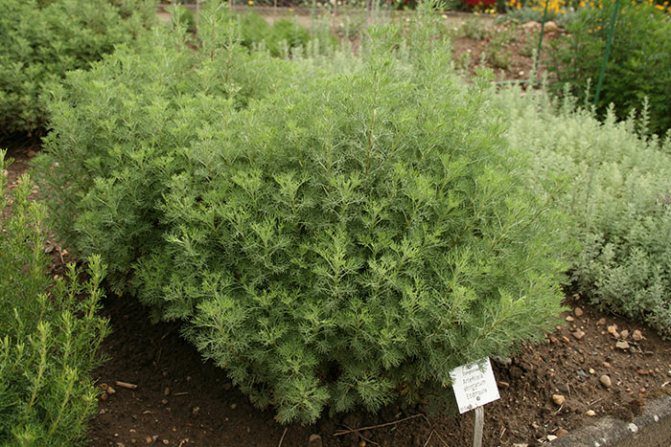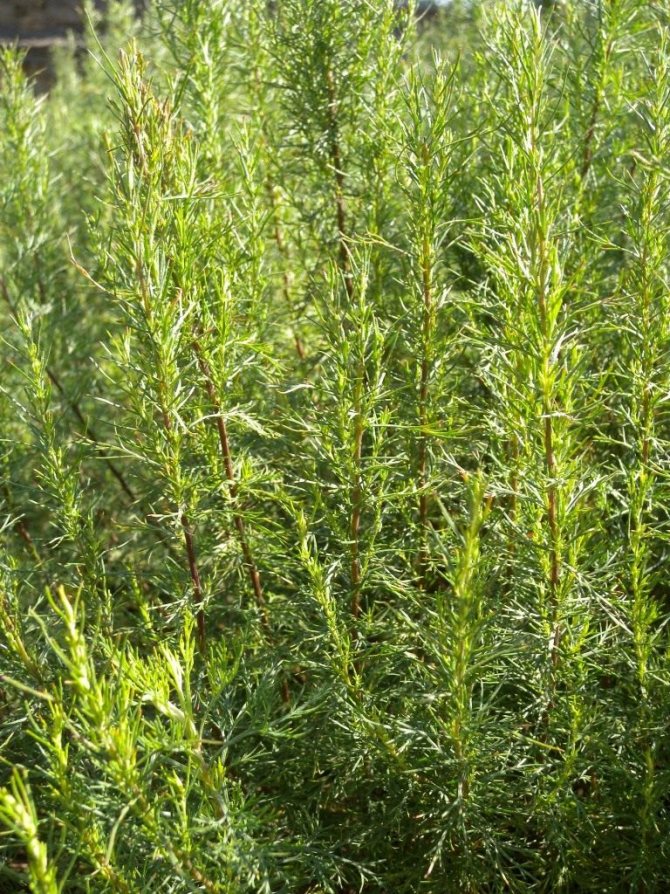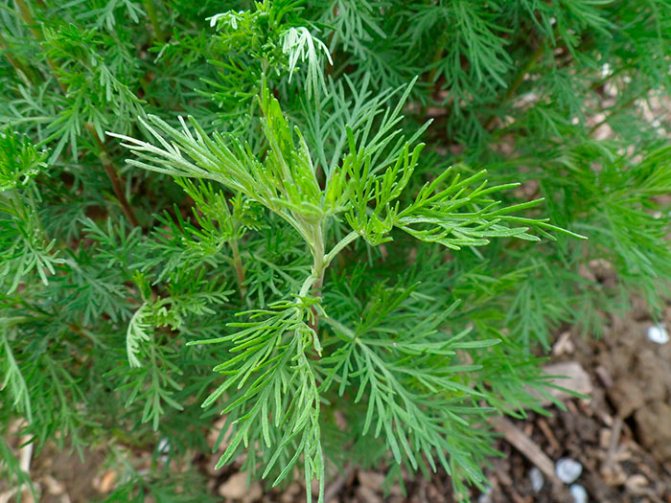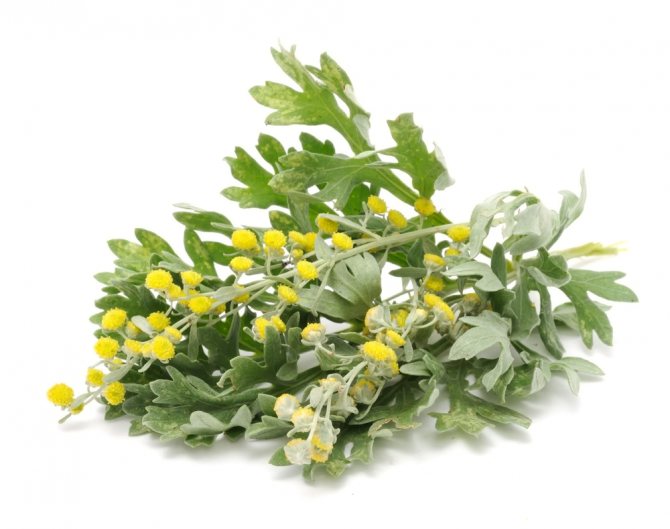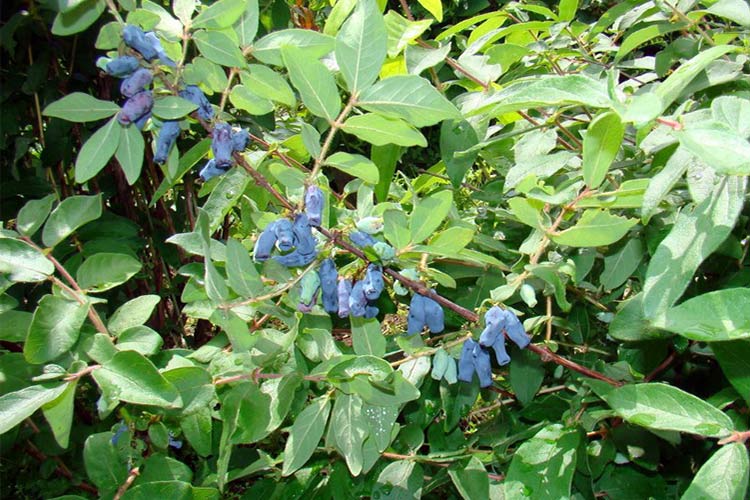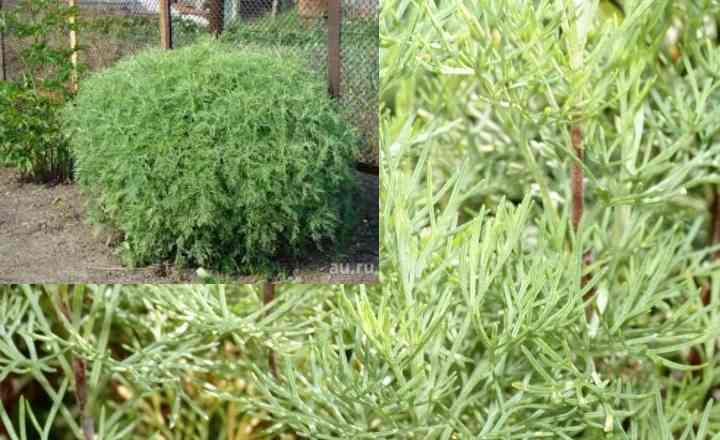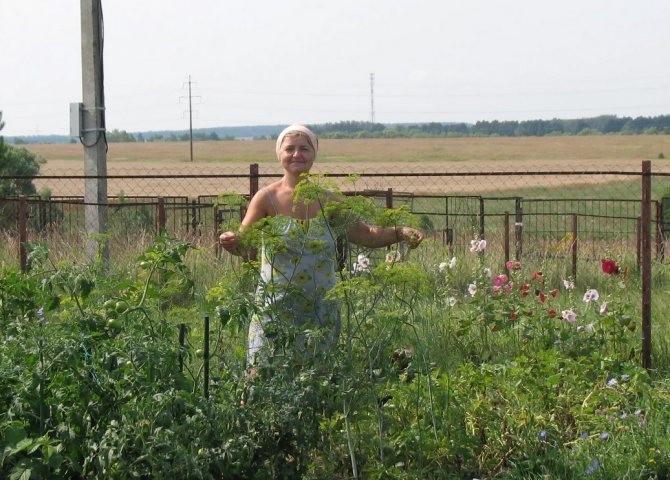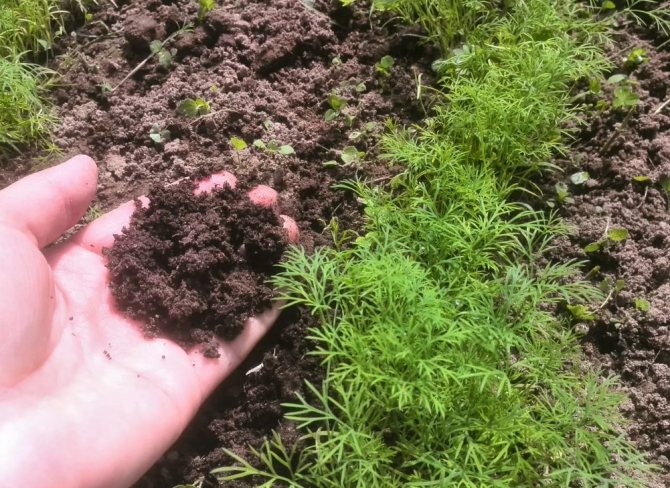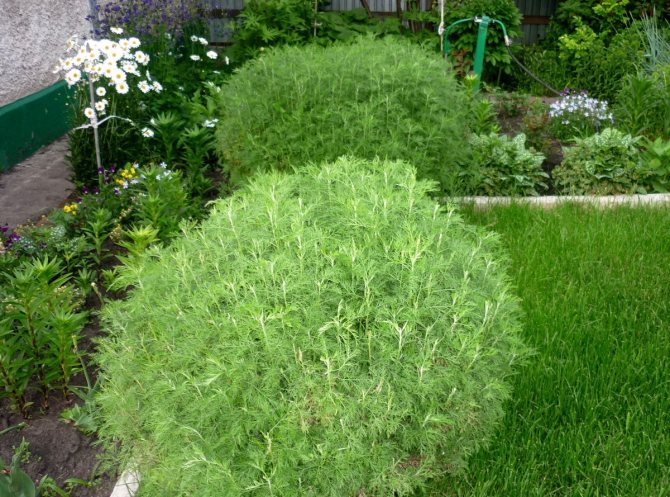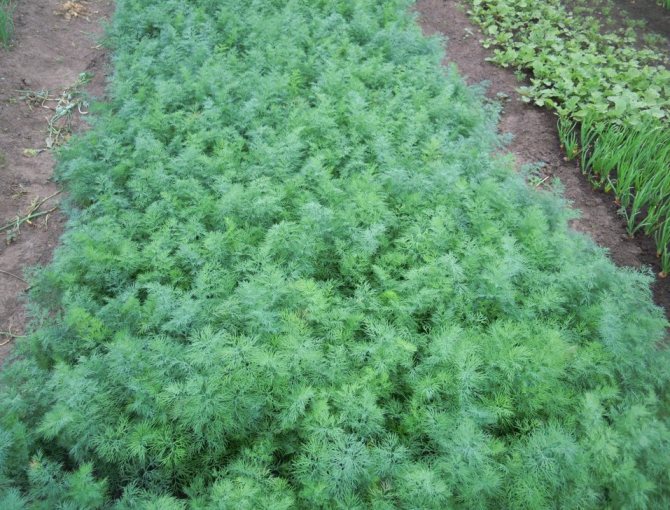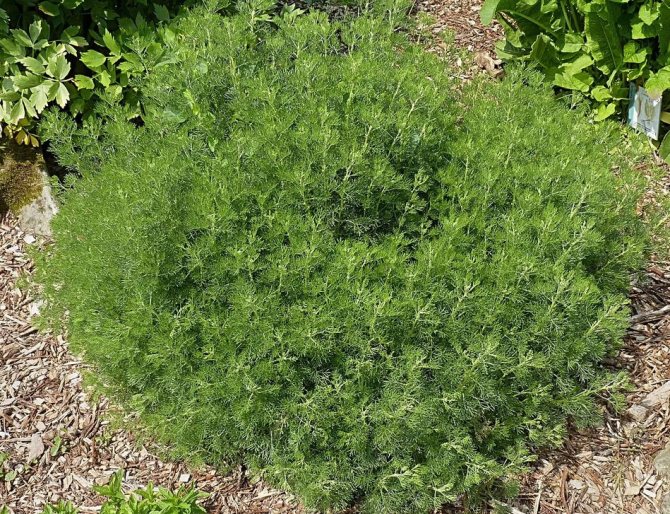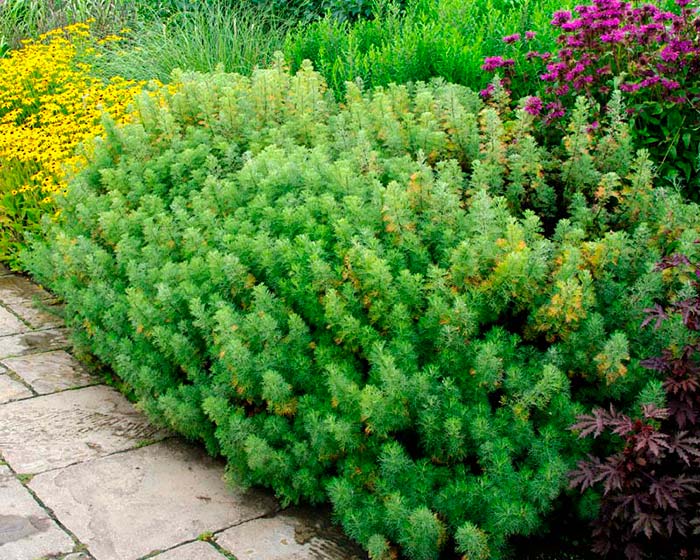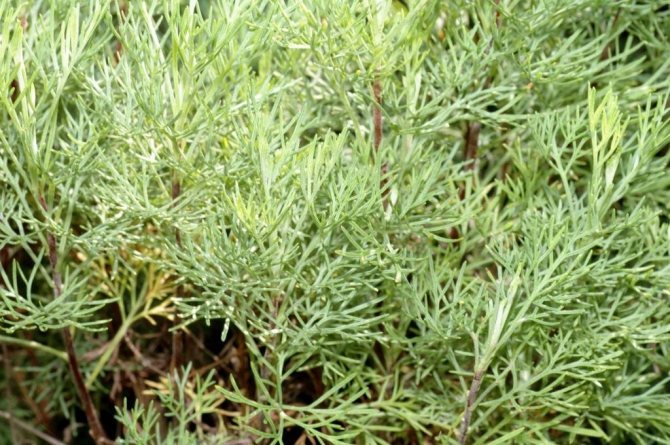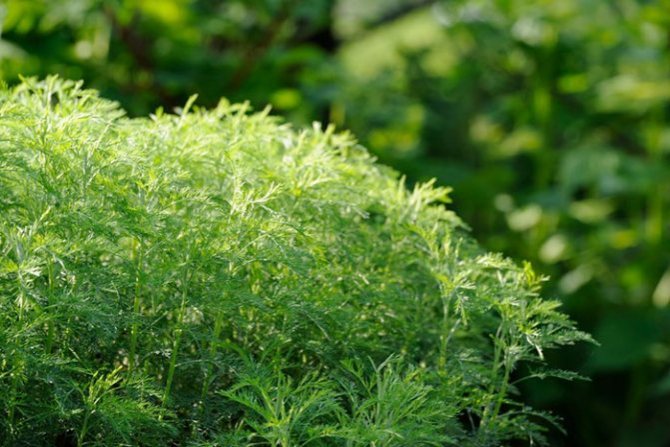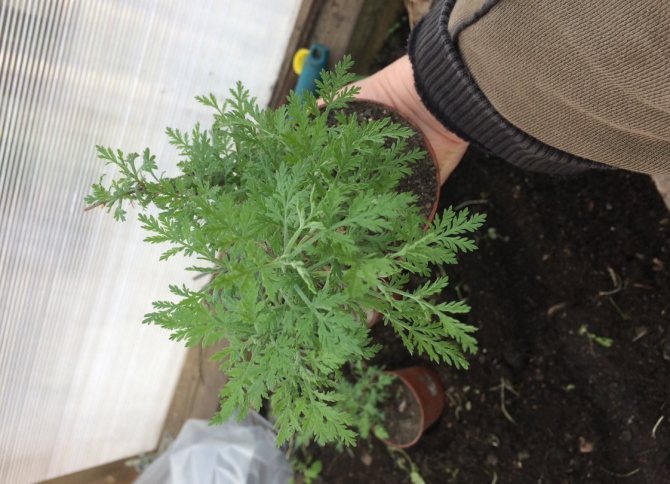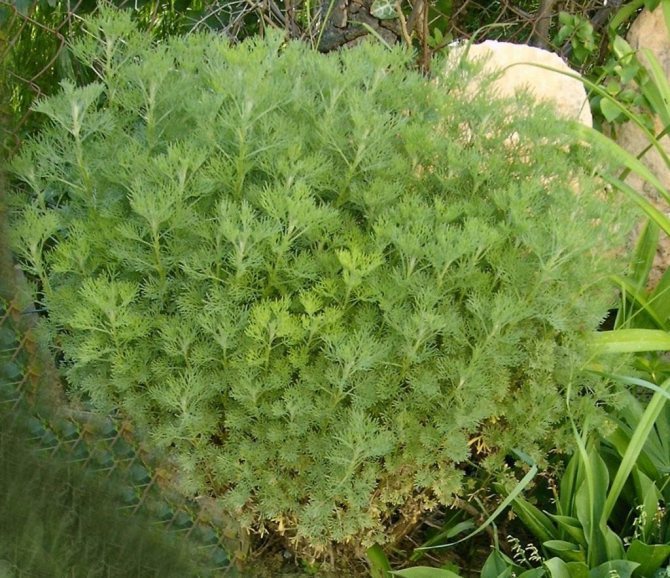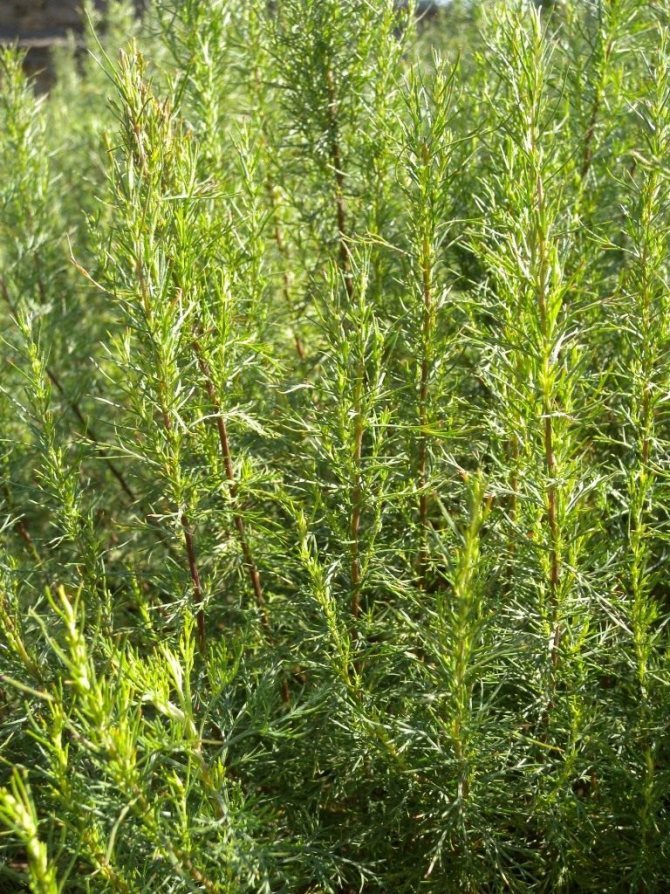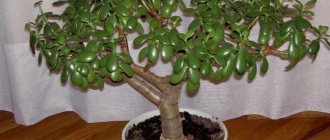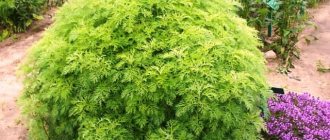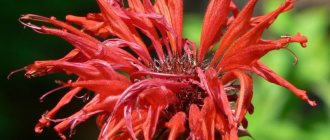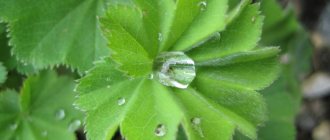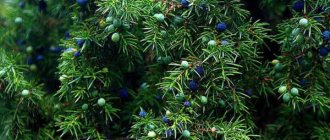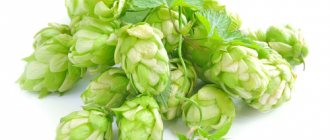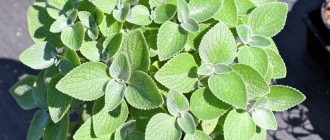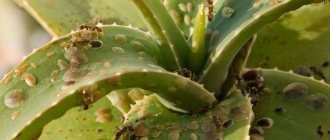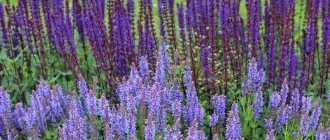What does wormwood-divine tree look like and what is included in its composition?
Wormwood is a well-known culture that grows almost everywhere in nature: in forests, in gardens, in meadows, in wastelands, etc. There are a lot of its varieties. Between themselves, they differ in appearance and content of chemical compounds. Botanists describe Abrotan as follows:
- A perennial shrub belonging to the Aster.
- Its height can be from 90 to 120 cm.
- Growth of almost completely lignified shoots is directed vertically. Their diameter is about 1.5 cm. They have no branches.
- Leaves are compound, pinnately dissected, gray-green in color. Their lobes are very thin, almost threadlike, which gives an openwork appearance.

- Yellow inflorescences in the form of small baskets are located on drooping peduncles. They appear in July-August.
- The fruits of the divine tree are achenes.
- The rhizome of the semi-shrub is pivotal, extending far into the soil.
- All parts of the plant are endowed with a strong aroma. Some people compare it with the smell of pine needles, lemon and dill at the same time.
- In nature, wormwood abrotan is found off the shores of various reservoirs. Used by gardeners as an ornamental plant.
Attention! You can only collect the plant yourself in ecologically clean places.
God's tree contains the following substances:
16 excellent varieties of plums for the Moscow region
- alkaloid abrotanine;
- essential oil;
- tannins;
- bitter substances;
- vitamins A, B, C;
- organic acids and resins.
Dill tree propagation and planting methods
A perennial plant is bred by different methods. Vegetative methods are popular, which are more productive and simple. In the middle lane, reproduction by seeds is impossible, even for the reason that in such agro-climatic conditions the seed does not ripen.
By dividing the bush
The technique is suitable for well-developed plants. The time of the event is the end of April. Step-by-step instruction:
- Choose a large bush.
- Dig up, remove the soil from the roots.
- Divide into parts so that each division has roots and several shoots.
- Bushes are planted.
For your information!
The planted wormwood is systematically watered until rooting, which is noted, as a rule, after 12-15 days.
By cuttings
A quick and easy way, in which cuttings 15 cm long are cut from the shoots. Fertile soil is prepared at the planned growing site. In the latter, shoots are buried, which are covered with plastic bottles to create a greenhouse effect.
Layers
Another simple method. Sequencing:
- At the end of spring, shoots of 20-30 cm are chosen, foliage is removed from them.
- They make cuts on them in a circle, apply a growth stimulant so that the roots form faster.
- Cover with moss on top, which is fixed with film and tape.
- When the roots begin to break through the sphagnum, part of the shoot (below the film) is cut off and planted in a permanent place of growth.
Seeds
The generative breeding method is used in the southern regions. However, indirect sowing is carried out. First, the seedlings are grown in separate peat pots, from where the plants dive after the development of the root system.
Healthy plant
The benefits of abrotana and significant contraindications for admission
Wormwood preparations can have a significant effect on the human body:


- The substances contained in the plant normalize the excretion of bile and increase the production of digestive juices in the stomach.
- The preparations of the god tree are able to relieve spastic pains.
- They have antifungal properties.
- In some cases, they act as an antipyretic agent.
- They help to eliminate inflammation, quickly heal wounds.
- They have a positive effect on the nervous system.
- When used as a cosmetic product, abrotan preparations, due to the presence of tannins, eliminate the unaesthetic shine and "force" the sebaceous glands to work normally.
Separately, we can say about the benefits of the tree of God for the female body:
- The plant is able to stop heavy bleeding during menstruation.
- Relieves pain symptoms with monthly bleeding.
- Wormwood preparations normalize the state of the body in the climacteric period.
- This herb is used as an adjuvant in the treatment of genital infections in women.
There are a lot of contraindications to taking God's tree drugs, because the plant has a strong effect on the human body. The main ones are:
- chronic and acute gastrointestinal diseases;
- insufficient amount of hemoglobin in the blood (anemia);
- pregnancy;
- you can not take drugs for children.
Signs that an urgent need to stop taking drugs are nausea, vomiting. These signs indicate an individual intolerance.
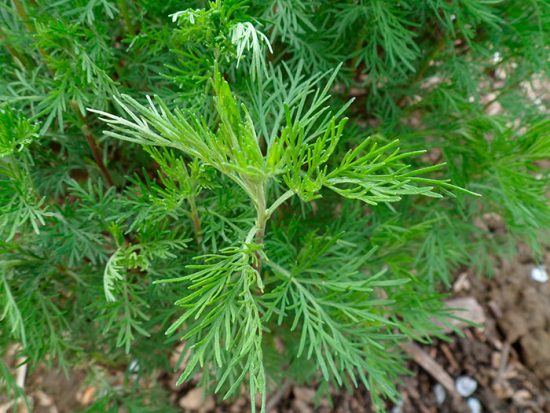

How to prepare wormwood on your own and what preparations can be prepared at home
Wormwood is harvested during the flowering of the plant. To do this, cut off the upper parts of the stem and dry them in a well-ventilated, shaded place.
Attention! To store a dry plant, in order to avoid weathering of essential substances, it is necessary in a hermetically sealed container, preferably made of glass, for no more than 2 years.
Examples of some alternative medicine recipes
Flower bed design. TOP 10 simple and effective techniques
- Wormwood oil abrotanum. For this preparation you will need a fresh plant, recently cut. They are completely filled with glass containers, after which they are poured with oil (preferably olive). The drug is infused in a dark place for two weeks. After it is filtered. Applied externally for skin diseases and internally for colds, bronchitis.
- Broth to improve appetite. They use a mixture of wormwood and yarrow (1: 1). Ready collection, in the amount of 2 tsp, pour 2 tbsp. boiling water. They insist for half an hour. Take 1 tablespoon 30-40 minutes before meals.
- Infusion to normalize the menstrual cycle. 1 tsp wormwood is poured with a glass of boiling water. Insist under a tightly closed lid for about 40 minutes. Take 1-2 tbsp during the failure period. before eating.
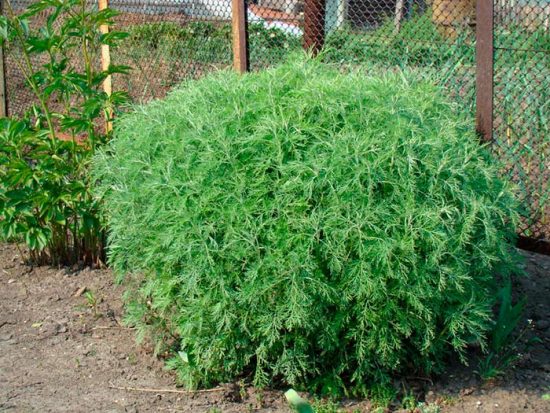

- A wonderful remedy is a bath procedure using a broom made of wormwood twigs. After it, muscle tension goes away, headaches are significantly reduced.
God's tree is an amazing plant that sometimes grows just under your feet. But only after consulting a doctor, and only with the correct use of drugs made from it, you can not harm, but significantly improve the condition of some organs and the whole body as a whole.
Growing features
If a plant is not grown for the purpose of creating landscape design, as such, the rules for growing it are not followed. Any soil will suit him, with the exception of sandy soil. Wormwood is not afraid of low temperatures and snowless winters. But in order for the shrub to grow better, it is worth familiarizing yourself with some conditions.
Lighting and wind protection
Abrotane is a southern shrub that prefers a warm climate and areas that are well lit by the sun. The plant develops poorly in shaded areas, so there should be no shadow in the place of its future planting.
See also
How can you keep dill fresh for the winter at home, the best ways
To read
Also, abrotans can damage the cold northerly winds. To avoid their influence, the shrub is planted next to trees and tall grasses, which will protect its effects from the wind, but will not interfere with the sun's rays.
Soil for planting
The culture prefers loose and nutritious soils. If necessary, the depleted soil is flavored with organic fertilizers. In case of increased acidity, it is preferable to neutralize it with dolomite flour, otherwise the plant may die.
No transplants are required for the god tree. The shrub grows and develops in one place for 10 years or more. Therefore, his choice is taken quite seriously.
Sapling planting technology
Planting is carried out in a soil soaked in warm water and fertilized with humus. This process is performed in the second or third decade of April. During this period, the moisture content of the soil is quite high, which contributes to better rooting of the seedling, even in the absence of watering.
Saplings are planted at a distance of 1.5 meters from the bush bush, which contributes to their better growth.
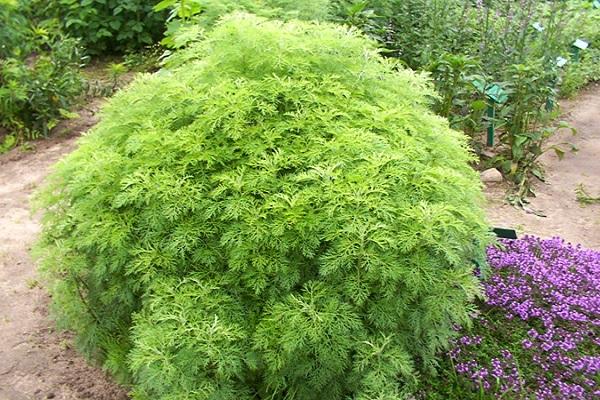

Wormwood - God's tree, medicinal properties
Wormwood is popularly called the tree of God, or Artemisia abrotanum - one of the many species of this plant. The leaves of wormwood contain a large amount of valuable essential oil, but, unlike other plant varieties, there is not much bitterness in its composition. Therefore, it is this type that is used to flavor food and various tinctures.
Read also: Buy seedlings of fruit trees, bushes St. Petersburg, Svyatovit
It must be said that the plant has many healing properties, therefore it is actively used in folk medicine. The ancient Slavs considered it an object of worship, used it to cleanse both the physical and spiritual world. Until now, healers believe that its smell expels evil spirits, therefore, wormwood is used as a talisman against the evil eye and damage.
The wormwood plant, otherwise the tree of God, whose medicinal properties have been known for a long time, must be able to distinguish it from the extremely common wormwood in Russia (Artemisia scoparia, or procera), which is also often called the God's tree. Outwardly, they are similar, but there are still differences.
Real healing wormwood is a perennial shrub that has beautiful openwork foliage that resembles dill leaves. If you pick a twig, rub it in your palms, a tart, pleasant smell of wormwood will appear in combination with lemon.
Wormwood paniculata - biennial. Its leaves and stems are much rougher, and the smell is less pleasant. In addition, it reproduces with the help of seeds. And in wormwood, under our climatic conditions, they do not ripen. Seeds of this species can only be obtained in areas with very warm climates. Therefore, it is propagated vegetatively (by dividing the rhizome or cuttings).
How to use God's tree for medicinal purposes?
For cancer of the stomach, intestines, uterus, use the root of the plant. You need to prepare a decoction: Grind the pre-dried wormwood root. Now put 2 tbsp. l. raw materials in a small saucepan, add 1 cup of pure boiling water. Boil, simmer at a very light boil for no more than 10 minutes. Then wrap it up with a warm cloth, wait until it cools. Strain, drink a sip before meals (half an hour). The whole broth must be drunk in a day.
For the treatment of neuroses, joint diseases, gout, the same infusion is added to the water when taking a bath (2 liters per one bath).
On the basis of the plant oil, the drug "artemizol" is made, with the help of which kidney stones are treated.It has antispasmodic properties, dissolves salts in urine well, actively removes sand and urinary stones from the body.
Traditional medicine uses an infusion based on the herb wormwood as a mild diuretic, and oil as a mild laxative.
For the treatment of epilepsy, an infusion of wormwood is used as an effective anthelmintic. To prepare the infusion, pour 1 tbsp. l. dry herbs with a glass of boiling water, wrap well, wait until it cools. Strain, drink a glass between meals.
As a tonic, tonic, as well as to get rid of worms, for the treatment of nervous diseases, prepare the following decoction: pour 1 tbsp. l. dried herbs 1 cup freshly boiled silicon water. Put in a water bath, simmer for half an hour. Then wait until the broth cools down, strain, drink a third of a glass before meals (half an hour).
With leucorrhoea, diseases of the stomach, intestines, with the complex treatment of infectious diseases, you can prepare wormwood or tea. To do this, fill in 1 tbsp. l. dry or fresh herbs 1 cup clean boiling water. After 15 minutes, as the tea is brewed, you can drink it whenever you want. But it is better not to consume it more than 3 times a day.
Medicinal wormwood is used in combination with other medicinal herbs. For example, an infusion of a mixture of wormwood, a medicinal letter is used for the complex treatment of sciatica. In combination with rue, wormwood is used as an analgesic, antispasmodic agent for renal diseases.
For the treatment of abscesses, finely chopped leaves of fresh wormwood are steamed with boiling water. Then they cover the damaged area with a steamed mass, bandage it with a bandage. Very often this remedy is used to treat inflammatory processes of the mammary gland.
In addition, traditional medicine uses wormwood-based ointments to heal skin lesions such as wounds, abscesses, frostbite. Also, for the same purpose, freshly squeezed plant juice is used.
Another use of God's tree
In addition to its medicinal properties, the god tree is used in cooking. Fresh, dried herb is added when roasting meat, especially game. This seasoning is very good in fried poultry dishes.
In household use, wormwood is used as a flavoring agent by hanging branches in a wardrobe. In addition to imparting a pleasant scent, wormwood will protect outerwear from moths.
It should be noted the very attractive appearance of the plant. Therefore, gardeners and summer residents are happy to grow lush bushes on their plots. It is often planted in not very pretty corners of the garden to cover, for example, a compost pit or a well.
Therefore, grow this useful plant on your site, admire its beauty, use it in the treatment of various ailments. Just before using God's tree as a medicine, do not forget to consult with your doctor. Be healthy!
Important points of care
Healthy plant
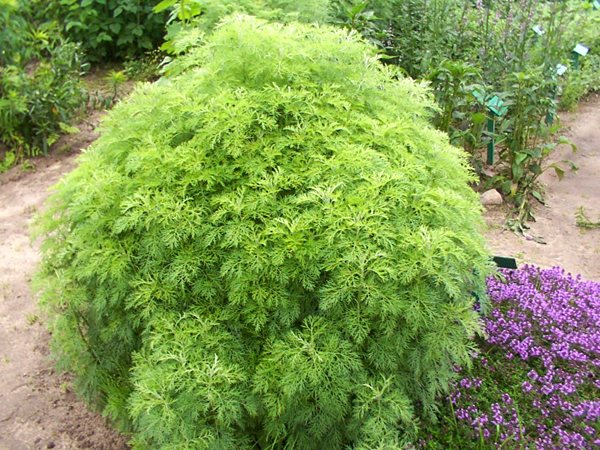

Some gardeners say that wormwood grows well even without proper care. However, to create a beautiful plant, you still have to make an effort. The secrets of planting and caring for tree wormwood include a number of activities that contribute to the successful development of the plant.
Humidification frequency
Since the god tree is quite resistant to dry periods, it does not need abundant watering. On hot days, it is moistened once every 14 days, pouring at least 4 liters of water under each bush.
Often, aphids settle on the leaf plates of a plant, which adversely affects its decorative effect. To get rid of it will help the treatment of wormwood with soapy water: 200 g of laundry soap is taken for 10 liters of liquid. The bushes are sprayed 3 times every 7 days.
Growing wormwood is not possible without regular pruning.It is best to prune the divine tree in early spring when severe frosts are behind. Young shoots are shortened to a height of about 5 cm.
If other related species easily propagate by root layers, then the rhizome of the dill tree does not give such shoots, but the bush is easily cuttings, plants can be divided, and viable layers can be obtained from above-ground shoots.
When, in the second half of June, the young branches of the dill tree begin to harden:
- cuttings are cut from 10 to 15 cm long, with 3-4 internodes;
- for a day, planting material is immersed by 1.5–2 cm in root or heteroauxin to stimulate root formation and growth;
- the cuttings are washed and planted in a mixture of one part of humus and two parts of sand, deepening by 2-3 cm.
Young plants should be covered for up to 6 weeks. At this time, a container with rooting cuttings of a dill tree is regularly watered and monitored to prevent decay of the shoots. In the second half of August, seedlings with the formed root system are transplanted into open ground.
If the planting material was harvested in the second half of summer, then it is better not to transfer the seedlings to the garden, but to leave them for the winter on a cool terrace or even in a room. In cold wintering conditions, plants are watered no more than 1 time in 7–10 days, while medicinal wormwood usually sheds almost all the foliage, the growing season stops, and buds form at the attachment points of the lateral leaves, which will start growing in spring.
If there is already a dill tree on the site, small parts with 3-4 branches and a sufficiently developed rhizome can be separated from an adult bush with a shovel.
If the gardener was able to get small seeds of this unusual plant, then a dill tree can be grown from them only through seedlings. When a dill tree is grown as an indoor crop, a fast-growing shrub must be cut off and actively fed, because a young plant can form up to 20 shoots of 75 cm in length per season.
For successful growth, a dill tree needs a place with a good dose of sunlight. The southern plant does not tolerate drafts and needs protection from the wind; it is better to plant it along a structure or hedge.
They dig up the bed, add rotted compost, manure. For 1 sq. m will require 6 kg of organic matter. From minerals:
- 25 g superphosphate;
- 15 g of ammonium nitrate;
- 15 g of potassium chloride.
The holes are formed at a distance of at least 1 m from each other. After planting, young plants are watered, in the first days they monitor the condition of the soil, do not allow drying out or waterlogging. Three more dressings will be required per season.
The latter is done in late autumn, introducing organic matter into the site. For ten years, wormwood medicinal does not need to be transplanted. In addition to watering, the plant requires weeding, loosening the soil, pruning damaged branches.
Cuttings of wormwood are carried out at the beginning or at the end of summer. Cuttings rooted in June are planted in open ground no later than August. This is necessary so that the plants can get used to new conditions and get stronger.


Protect the plant from drafts
If the branches were cut at the end of summer, then it is better to leave them in the house for the winter. A cool veranda or a glazed loggia is well suited for this. It is quite possible that the wormwood will throw off the leaves, this is not scary, in the spring new shoots will grow from the buds.
Attention! Winter watering of medicinal wormwood is minimized.
God's tree is not only a useful culture, but also an incredibly decorative culture. In the garden, lush bushes of medicinal wormwood are planted in flower beds. A fast-growing culture is used as a living fence of the site and as a curb along paths and alleys.
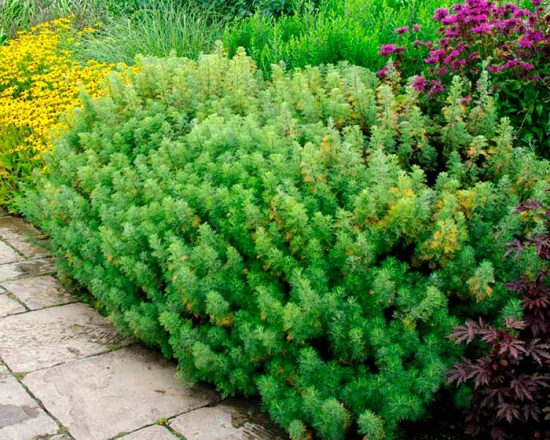

God's tree in landscape design
Several species of different flowering times can be placed nearby. Thus, the composition will always attract attention.
Quite often, gardeners form a god tree in the shape of a cypress, the cone-shaped crown and carved foliage add even more to the plant similarity to southern conifers.
Abrotans are also used for landscaping terraces, open verandas, and balconies. Wormwood is planted in wide flowerpots or containers.
You can also find seeds of the god tree in stores. One month after planting them, you will have young seedlings ready for outdoor conditions. Interestingly, the seeds are able to remain viable for about 70 years after harvest.
God's tree: medicinal properties and contraindications
The plant of God tree or Chernobyl is known to everyone under the name wormwood - this is the name it received among the people. This shrub belongs to the Asteraceae family.
We invite you to find out if the tree of God has medicinal properties and contraindications, how to use it correctly for medical purposes, does it only benefit or can it cause harm?
They learned about the medicinal properties of this plant in ancient Greece - then its leaves began to be used to treat wounds and cuts, adding to ointments. It is so useful due to the high content of citral in it (it is he who gives these citrus notes in the aroma), tannins, ascorbic and organic acids, glycosides, flavonoids, salts of the element potassium, carotene and other various macronutrients.
Read also: How to grow ginkgo biloba at home and outdoors
God's tree is a storehouse of medicinal properties. The ancient people gave him several more names: wormwood of the Crimean or Tauride species, lemongrass, holy tree, etc.
Contraindications to the use of the divine tree include the period of pregnancy and lactation. It is strictly forbidden to use any decoctions for pregnant women, because this can adversely affect the health and development of the fetus.
The use of wormwood for anemia is also not recommended. Most doctors attribute nausea and vomiting to contraindications for the use of the tree of God. Treatment with this herb should be avoided in case of individual intolerance, in case of allergic reactions of the human body. The application should be limited to a month, so that later there are no seizures or hallucinations from an overdose.
What types of abrotana are known?
There is a variety of abrotane species in nature. More than half of them are resistant to low temperatures. The European population is familiar with the divine tree - a representative of medicinal varieties.
Due to its therapeutic effect, wormwood is popular with many gardeners.
Treelike varieties are preferred by Mediterranean climates. Border species are mainly bred here.
In the mountainous regions of the southern European region, the Caucasian wormwood grows. Its height does not exceed 30 centimeters.
Tarragon or in another way Tarragon is another subspecies of the dill tree. The shrub is quite tall, its stems sometimes reach a meter mark.
Cold wormwood is a low-growing plant common in the southeast of Russia.
Lactobacillus aborotan is found in China. The length of its shoots is 1.5 meters; small buds of a light shade develop during flowering.
The wormwood variety Louis is widespread in Latin America.


Wormwood divine tree: description and application
Medicinal wormwood is a perennial herb that blooms with small white or yellow flowers. It has a very tart aroma, and its leaves resemble dill leaves in appearance and contain a large amount of essential oils. The tree of God is very often used in folk medicine, cooking, in everyday life, it is grown in gardens and vegetable gardens as an ornamental or indoor plant.
In medicine, a silvery type of bitter wormwood is still used. But how not to call it - the healing properties remain the same.Decoctions of this useful herb treat diseases of the oral cavity, the remedy can also be used to get rid of infections in the throat.
Bitter wormwood tincture is widely used to wipe the skin with dermatitis, it also takes care of the hair - rinses the hair and scalp after washing.
God's tree is a very healing drug that has more than one application:
• The decoction is used to treat dislocations / bruises - compresses are applied to the affected areas. • Medicinal wormwood treats inflammation of the periosteum - take the substance in the form of alcohol tincture. • Helps relieve stress, fatigue, headaches. • Recommend the use of tea and tea for insomnia and fatigue. Its lemon scent promotes sound sleep. • The medicinal composition of the plant helps to cope with hypertension. It will not be possible to completely get rid of it, but the symptoms of wormwood will remove in no time.
Prepare the herb of the divine tree should be in the summer. You can start collecting and harvesting from mid-July and finish in September. Green leaves are dried in a dark, dry place without drafts on spread newspaper or burlap.
Health Benefits of the Divine Tree
With the help of the tree of God and its medicinal properties, you can improve the functioning of the gastrointestinal tract, get rid of pain from heartburn, sore throat. But here you need to properly prepare a decoction, tincture or tea. How exactly to do this and what recipe to choose for the treatment of various diseases, we will tell you a little later.
The benefits of the use of medicinal wormwood. Or as it is also called tree / bitter, very large. It can significantly help with the normalization of the menstrual cycle, with cancer, help get rid of parasites, relieve tension, stress.
A lot of folk recipes have been collected using this type of wormwood paniculata. And all because this complex-flowered plant with openwork foliage contains a lot of useful vitamins, medicinal properties and acids.
It is also worth using wormwood with caution - it brings not only health benefits, but can also cause harm in case of an overdose. You should definitely consult with your doctor so that he prescribes the correct treatment and application, tells how to drink herbal tincture.
There is little bitterness in the tree of God, so it can also be taken by children (we will tell you about contraindications for use a little later).
Description
The homeland of the arboreal wormwood (Artemisia abrotanum) is considered to be the temperate regions of the Northern Hemisphere. The divine tree easily takes root in places with an arid climate, on sandy soil or high hills, it is well developed on the banks of reservoirs and rivers. Science knows 250 species of this plant. They are used to create decorative compositions for the garden and suburban area.
- Abrotan leaves have a pinnately dissected formation and a light gray tint, and its stems and root are woody.
- Shoots are erect, petioles are observed on the middle and lower tier of the plant.
- The buds resemble small baskets, which are combined into paniculate inflorescences of a loose structure.
- Arboreal wormwood begins to smell sweet in early to mid-summer.
- The shrub emits a strong lemon scent that repels insects. This property is highly regarded by gardeners.
Treelike wormwood recipe for colds
Artemisia is used to prepare oil for colds. The recipe is very simple. You need to take an earthen vessel and completely fill it with flowers and leaves of the divine tree. Pour olive oil over it to the brim of the vessel.
The resulting product must be insisted for about 10 days so that the oil is saturated with the healing properties of wormwood. The composition must be filtered after the expiration of time and consumed 1 tsp. with angina, group or ARVI. How to determine that the oil has begun to have healing properties - it should change color to dark green.
Tinctures of God tree for gastrointestinal diseases
Wormwood tea will help to cope with diseases of the stomach, intestines, duodenum, etc. 1 tablespoon dry / fresh herb (leaf and flowers can be mixed) pour a glass of water, preferably boiling water.
Read also: Cardiocrinum (giant lilies) - an unusual plant for your garden
Wait until brew for about a quarter of an hour. Tea should have not only medicinal properties, be beneficial, but also smell very pleasant. Application: how to drink? 4 - 5 times a day.
It is very useful to drink it in winter - the body will receive strength to fight infectious diseases.
Benefits of god tree leaves for skin and hair
Tincture, decoction or mask is an effective remedy in the fight against hair loss, increased fat content, dandruff, will add volume and return shine to dull curls. Rinse broth recipe: tbsp. Pour herbs over with boiling water, cook over low heat for about five minutes. Remove from heat, strain and add 1 liter of water. Apply after each hair wash.
How to care for hair that falls out? You can make a god tree mask. She has no contraindications (except for allergic reactions) and you are not threatened with a side effect. Pour a glass of light beer and 2 tbsp into a saucepan. wormwood. Bring the mixture to a boil, cool, and apply to individual strands of hair and scalp. Exposure time: 20 minutes.
A well-known recipe for hair loss:
Add wormwood to white henna until gruel is formed. This mask should be done once a week. It is applied to the hair, covered with plastic and kept for an hour. The effect of the previous mask will be different - the hair will become more luxuriant.
In order to prepare a face lotion from herbs and leaves of the tree of God, you need to take a tablespoon. bases, salt 0.5 teaspoon and a spoonful of viburnum.
Recipe for cooking description:
insist wormwood in a glass of boiling water for half an hour, add the rest of the ingredients. A regular lotion will help get rid of acne. Such a folk tincture can also be cured of scars on the skin of the face. Store no more than 14 days in a refrigerator.
We suggest removing inflammation, smoothing fine wrinkles with the help of wormwood ice cubes. Freeze the broth in ice trays and wipe the skin in the morning and evening.
Lady tree leaf tea for health recipes
One of the recipes for wormwood tea is used to get rid of worms. It contains dried wormwood and cloves. Mix them thoroughly. How to drink? In the morning and in the evening, take one spoonful with carrot juice. Thus, the wormwood will get rid of worms, and the larvae will be removed by the carnation. Their bactericidal properties will help get rid of parasites in 10 days.
Recipe for yarrow and god tree tea will help restore your appetite. Half tbsp. mix herbs in a glass with boiling water. Strain.
How to drink? Drink 100 g three times a day on an empty stomach. You can take a week, after which it is recommended to take a break so as not to harm the human body.
Tincture of god tree root indications for use
Tincture of god tree (also called widow or Austrian bush) is widely used in the treatment of cancer in the initial stages. It is the wormwood root that is the main ingredient here.
Finely chop the dried root, add water and boil for 10 minutes under a closed lid. This rule exists so as not to affect the quality of the future infusion - the essential smell and oils can evaporate. Remove from heat and let the tincture cool down with the same lid closed. Strain the solution.
How to drink? - 2 tbsp. on an empty stomach for two weeks. Then you need to take a break of a month. This correct application will not cause overdose or harm.
God tree oil for skin diseases
The top of the herb is poured into a dark plastic container (to keep the light out of the oil), poured with olive oil, corked with a lid and left in a dark place for two weeks.
Strain the solution and store in the refrigerator. Take half a teaspoon orally before meals three times a day.
Decoction of the leaves of the tree of God for cancer
A decoction of wormwood leaves is not used to fight cancer; for this, the wormwood root is crushed.
And a decoction of the leaves of the tree of God will help you to cope with an unstable menstrual cycle. For this, fresh leaves are poured with boiling water and insisted for half an hour.
At the onset of menstruation, take 2 tablespoons 3 times a day. The cycle will become less painful and stabilize within 3-4 months.

